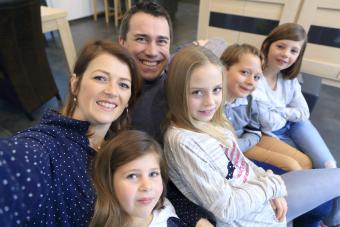
The definition of family continues to evolve, and nontraditional families are becoming more common. Many households have expanded the concept of family well beyond the traditional nuclear family comprised of one mother, one father and one or more children. Discover the many types of alternative families that are forming over time to accommodate cultural shifts and different lifestyles and priorities.
Types of Nontraditional Families
Over the past 50 years, there has been a steady decline in two-parent households and a steady increase in one-parent households. Now, only 62% of children live with two married parents, which is an all-time low. The remaining are part of alternative families. Some diverse home structures have risen due to parental needs, financial needs, and people finding love and partnerships in nontraditional ways.
Same-Sex Partner Families
Changes in laws and a cultural increase of acceptance of same-sex relationships, has made it more common for same-sex couples to cohabit, marry and adopt children. One concern that's expressed regarding same-sex parents is that their children don't have a role model of the opposite sex. However, gender is a social construct, and differs from the biological sex you are born with: male or female. Culture has determined what it means to be a boy, girl, man and woman, and the definitions are pretty arbitrary. For instance, contrary to gender norms, it is beneficial for men to nurture their sensitive side and for women to be assertive. What matters with parenting is not a certain formula but rather, love for the child and use of good parenting strategies.
Research has shown that childhood progress through school and adolescent psychosocial adjustment and school performance are not impacted by whether kids have parents of opposite sexes or same-sex parents. Additionally, children with either type of family structure are more likely to progress through school than children in shelters or orphanages.
Moreover, it has been suggested that same-sex couples are likely to be better parents, because their desire to be parents is underscored by the fact that they have so many more hurdles to get over to become parents: social stigma and discrimination, on top of what can be a long and arduous adoption process.
Blended Families
When single parents decide to marry or cohabit, this creates a new, blended family that consists of stepparents, stepchildren and/or half-siblings. This can lead to adjustment for all family members, as not only does it involve acclimating to living with new people, it also involves shifting interpersonal dynamics.
At the same time, children in blended families experience that it is not blood relatives necessarily, but love and respect that truly make a healthy family. Children's support networks can also expand with blended families. Furthermore, kids are able to adjust to changes such as divorce and remarriage if authoritative parenting strategies are used.

Extended Families
Also known as joint families, extended families consist of multiple generations living in one household. For instance, an elderly couple might live with their son, daughter-in-law and their grandchildren. Sometimes two siblings and each of their families may also live together.
The challenges of this family structure can include tension with in-laws or conflict due to differing parenting philosophies. However, if an agreement can be reached on how to cohabit peacefully, there are multiple benefits to the extended family structure. Folks are able to care for their aging parents and have help with parenting. The family saves money on living costs overall, and children are able to be closer with their grandparents.
Extended families are common in India, which has a culture that is much more on the collectivistic end of the spectrum, whereas the American culture is much more on the individualistic end. A collectivistic culture tends to value the family unit and community as a whole over an individual. Therefore, the family structure typically involves keeping family members closer together.
Families With Cohabiting Parents
Many couples, like Hollywood stars Goldie Hawn and Kurt Russell, are in very long-term relationships and have children, but they're not married. There are various reasons why people might decide to be together but not marry. They may have been married before, and don't care to get married again. Or they may have financial reasons for staying single. For example, one may have bad credit, and getting married can ruin the credit of the other.
Some couples may choose not to marry because it would be easier to leave each other in the event of a break-up. What is interesting about this rationale is that some couples use it as a way to have a happier relationship. Meaning, if one is able to leave at any point, and they ultimately want to stay together, they work to make each other happy every day.
One challenge of this family structure could be that once their kids are older, the couple may have to explain to them that they are not married and why. However, ultimately what matters for children is that they are loved and cared for and parents are modeling a healthy relationship.

Single-Parent Families
Single-parent households are now very common, with 26% of children having single parents. In the U.S. and across the globe, divorce has become more common and accepted, whereas in the past it was considered very taboo.
Besides divorce, other ways single-parent families are created is when people really want to be parents, but they either don't want to be married or in a long-term relationship, or they haven't found the right partner. Single parents often pursue parenthood through adoption or in vitro fertilization.
The challenge for single parents is managing parenting and the household on their own. However, there are benefits for both single parents and their kids. Many have become single parents because they were able to leave unhealthy or abusive marriages and thus, also removed their children from abusive environments.
Examples of Nontraditional Families on Television
Television shows have portrayed nontraditional families in positive ways, helping to normalize and reduce the stigma that can be associated with alternative families. The Brady Bunch was a blended family, Diff'rent Strokes featured a single white man who adopted two Black boys, The Gilmore Girls are a single mom and daughter duo, and Modern Family highlights same-sex parents and a blended family.
Love Should Be at the Core
Regardless of how a family is formed, what matters is that it consists of people who love and respect each other. Children thrive with positive role models, parental involvement and structure, and, of course, lots of love.







